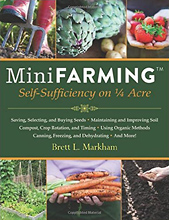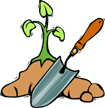
|
|
Planting and Caring for a New TreeWhen you have decided on which kind of fruit tree you would like, and where you would like it, you can finally start to plant it. If you buy your tree from a nursery, be especially careful when you are taking it from the nursery to your house. I once had a friend who put the tree in the back of his truck, but clipped a sign on the way home. The entire tree snapped in half, and my friend was left a very sad man. Water the Tree Before PlantingTrees should be watered thoroughly several hours before planting to moisten the root ball. Digging the HoleWhen you have gotten your tree safely back to your yard, look at the bottom of it and see how big the clump of roots is. It may seem like a lot of work now, but you want to dig a hole that is twice as wide as the clump, and just a little less deep. Making the hole slightly bigger than the clump of roots allows there to be room for the soil that you dug out to be put back in. Otherwise you would be stuck with a giant heap of unwanted dirt, and nowhere to put it. Planting Your TreeAfter you have dug the hole, line the hole with some compost or fertiliser so that the tree will grow better. After you have done this you should set your fruit tree into the hole, and spread the roots out evenly so that the tree will be strong and stable. Filling the HoleWhen all of this business is done, take the soil that you dug up and fill in the hole completely. Unless you want big piles of dirt everywhere, you should be sure you use all of the dirt even is it is a couple inches higher than the rest of your yard. This is because it will compress when watered. Before you firm up the soil, make sure that the tree is completely vertical and will not fall over. After you have checked that the tree is perfectly vertical you can gently firm up the soil. WateringAfter you have filled in the hole with soil, give your tree a good water. At least 20 litres of water should be applied to each tree to settle in soil around roots. StakingIf the tree's trunk is not yet completely sturdy and can be bent, you need to tie the tree to a stake with a bit of rope. Be sure not to tie the rope tightly to the tree, as you need to allow room for the trunk to grow. Once the tree is sturdy enough to withstand all types of weather, you can take the stakes off of it. When all of this is done you should mulch around the base of the tree. If you live in an area where wildlife can access your yard, then you should put a fence around your tree, because some animals will eat the bark off of young trees. See below for more on staking young trees. FruitingOnce you have successfully planted your fruit tree it will start to bear fruit after it is three to five years old. Once your tree starts to carry a lot of fruit you should periodically pick some of the fruit so that the branches aren't weighed down too much. If the fruit gets too thick, the branches can break off. On some years your tree might not bear as much fruit as others, but this should not worry you. Healthy trees often take years on “vacation” where they produce little or no fruit. PestsAfter you've planted your tree you might start to have some problems with pests. To help keep these pests away, always rake away old leaves, brush, or any other decaying matter that could be holding bugs that could be harmful to your tree. PruningTo make sure that your tree always stays healthy in the long run, you should prune it during winter or spring. WateringWater your tree every two weeks during dry times, and be sure not to hit your tree with a lawn mower or a weed eater because it could severely damage the growth process. Also just make sure that your tree gets plenty of water and plenty of sun, and your growing experience should be just great. Staking a Young TreeWhen a tree is in the young stages, one of the most vital things you need to provide for it in addition to water and nutrients is support. If you don’t hold up the tree somehow, it might end up bending in a certain direction and growing extremely crooked for the rest of its life. So no matter what, you should always have some kind of support. The most popular method of keeping young trees upright is to put long stakes into the ground on either side, and tie loops around the tree. Each loop should be fairly loose to allow for further expanding of the trunk. Lots of people just have a stake on one side of the tree, but this is not a good practice because it generally doesn’t allow for further growth of the tree. You should only be staking your tree if you think that wind and other forces might be literally moving the ball of roots within the ground. Your staking should prevent all of this movement, because this is the most harmful thing that can happen to a young tree. It causes the roots to be in motion too much and not be able to properly get a hold on the soil so that the tree can develop normally. Before you stake a tree, you should be completely sure that it needs it. If you constrict the movement and growth of a tree that doesn’t need to be tethered down, you could harm it beyond repair. For example, the staking mechanism you use could cause abrasion or “rashes” on the trunk. This will happen anyways, but why have it happen needlessly? Also, staking gives your yard an unnatural look and can present a hazard for people walking or running across the yard. The staking process is actually rather simple. Just take 3 stakes and tie each one separately near the base of the trunk. If you use some sort of tether to prevent rope burn on your tree, that would be an even better solution. These can be purchased at any gardening shop, and are designed to be friendly to the bark of the tree. It is much better to stick with these instead of bare rope, to minimize the amount of friction the tree endures. When you think your tree has been staked long enough to stand on its own, you should remove the stakes from the ground as soon as humanly possible. Every moment the tree is constricted it is losing some of its vitality. As soon as it seems like the wind is dying down around your area, look on the weather reports and see how much wind is forecasted. If the skies will be pretty clear for a while, you should at least temporarily take off the stakes. To wrap it all up, you should never deny your tree a good staking. It is a completely necessary thing to do in certain situations. It is very crucial to understand when those occasions are, though. Staking a tree that doesn’t need it can be as damaging as not staking a tree that does need it. It might be beneficial for you to consult an expert, and get their opinion as to whether your tree should be staked, and for how long. Recommended ViewingRecommended Reading
See AlsoSustainable Organic Farming Share This Pagefruit hole soil staking tree trees Content is copyright © Survival.ark.au 2005-2024 All Rights Reserved. Terms of Use. Definitely read the disclaimer before trying anything from this website, especially including the practices and skills. This website uses affiliate links – this doesn't cost you any more, but I get a commission on purchases made through the website. As an Amazon Associate I earn similarly from qualifying purchases. |
|


